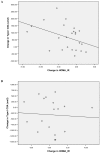Strength training improves muscle quality and insulin sensitivity in Hispanic older adults with type 2 diabetes
- PMID: 17211497
- PMCID: PMC1752232
- DOI: 10.7150/ijms.4.19
Strength training improves muscle quality and insulin sensitivity in Hispanic older adults with type 2 diabetes
Abstract
Hispanics are at increased risk of morbidity and mortality due to their high prevalence of diabetes and poor glycemic control. Strength training is the most effective lifestyle intervention to increase muscle mass but limited data is available in older adults with diabetes. We determined the influence of strength training on muscle quality (strength per unit of muscle mass), skeletal muscle fiber hypertrophy, and metabolic control including insulin resistance (Homeostasis Model Assessment -HOMA-IR), C-Reactive Protein (CRP), adiponectin and Free Fatty Acid (FFA) levels in Hispanic older adults. Sixty-two community-dwelling Hispanics (>55 y) with type 2 diabetes were randomized to 16 weeks of strength training plus standard care (ST group) or standard care alone (CON group). Skeletal muscle biopsies and biochemical measures were taken at baseline and 16 weeks. The ST group show improved muscle quality (mean+/-SE: 28+/-3) vs CON (-4+/-2, p<0.001) and increased type I (860+/-252 microm(2)) and type II fiber cross-sectional area (720+/-285 microm(2)) compared to CON (type I: -164+/-290 microm(2), p=0.04; and type II: -130+/-336 microm(2), p=0.04). This was accompanied by reduced insulin resistance [ST: median (interquartile range) -0.7(3.6) vs CON: 0.8(3.8), p=0.05]; FFA (ST: -84+/-30 micromol/L vs CON: 149+/-48 micromol/L, p=0.02); and CRP [ST: -1.3(2.9) mg/L vs CON: 0.4(2.3) mg/L, p=0.05]. Serum adiponectin increased with ST [1.0(1.8) microg/mL] compared to CON [-1.2(2.2) microg/mL, p<0.001]. Strength training improved muscle quality and whole-body insulin sensitivity. Decreased inflammation and increased adiponectin levels were related with improved metabolic control. Further studies are needed to understand the mechanisms associated with these findings. However, these data show that strength training is an exercise modality to consider as an adjunct of standard of care in high risk populations with type 2 diabetes.
Conflict of interest statement
Conflict of Interests: The authors declare no conflict of interests.
Figures
References
-
- Zierath JR, Krook A, Wallberg-Henriksson H. Insulin action and insulin resistance in human skeletal muscle. Diabetologia. 2000;43:821–35. - PubMed
-
- Castaneda C, Bermudez OI, Tucker KL. Protein nutritional status and function are associated with type 2 diabetes in Hispanic elders. Am J Clin Nutr. 2000;72:89–95. - PubMed
-
- Wallberg-Henriksson H, Rincon J, Zierath JR. Exercise in the management of non-insulin-dependent diabetes mellitus. Sports Med. 1998;25:25–35. - PubMed
-
- Dutta C. Significance of sarcopenia in the elderly. J Nutr. 1997;127:992S–3S. - PubMed
Publication types
MeSH terms
Substances
Grants and funding
LinkOut - more resources
Full Text Sources
Medical
Research Materials
Miscellaneous


